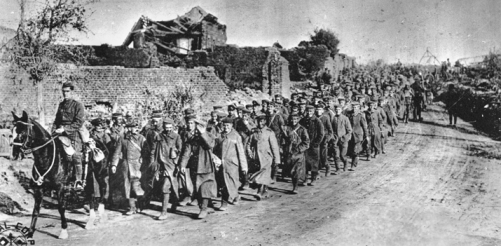Old Hickory Division
The Old Hickory Division, a World War I unit, initially consisted of National Guard units from North Carolina, South Carolina, and Tennessee. Officially the Thirtieth Division, it was nicknamed in honor of general and seventh U.S. president Andrew "Old Hickory" Jackson, who had connections with all three states. The division was formed on 18 July 1917 at Camp Sevier near Greenville, S.C.; later the state National Guard distinctions were eliminated. In October 1917 additional draftees from North Carolina, South Carolina, Tennessee, Kentucky, Indiana, Illinois, Iowa, Minnesota, and North Dakota increased the Old Hickory's ranks to full wartime strength of approximately 27,000 men. Ninety-five percent of its original members had American-born parents, a rarity when compared to other U.S. divisions in World War I. Further, Old Hickory contained more North Carolinians, and its soldiers were awarded more Congressional Medals of Honor, than any other division.
In April 1918 the Old Hickory Division prepared for transfer to Europe. On arrival in France, the Fifty-fifth Field Artillery Brigade, including the 113th Artillery Regiment, was detached and assigned to the American Expeditionary Force. The rest of the division went with the American Second Corps, attached to the British Army in northern France. In July 1918 Old Hickory joined the British Second Army in Belgium, where it received additional training for combat. On 16 August the division was sent to the trenches in the canal sector between Ypres and Voormezeele in anticipation of the British Ypres-Lys offensive. On 1 September, following a British artillery barrage, both regiments advanced. During the next two days of fighting, they captured all of their objectives, including Lock No. 8 on the Ypres Canal, Lankhof Farm, and the village of Voormezeele. The North Carolinians in the two regiments inflicted about 300 enemy casualties in the 1,500-yard advance, with a loss of 37 dead and 128 wounded.
On 20 Sept. 1918 the American Second Corps (composed of the Twenty-seventh and Thirtieth Divisions) was transferred to the British Fourth Army, and by 25 September the U.S. divisions were in position opposite the Hindenburg Line's St. Quentin trench complex in preparation for a massive assault on the German lines. Under cover of darkness, U.S. divisions captured the German outpost line, and the British bombarded the enemy with artillery fire for two days. North Carolinians ventured into no-man's-land to run barbed wire and to prepare paths through the wire for the attacking infantry. At 5:50 a.m. on 29 September, the corps attacked. Due to high casualties, barbed wire entanglements, and smoke from shellfire, the advancing lines lost all sense of organization. Despite the confusion and losses, the North Carolinians of Old Hickory broke through the Hindenburg Line by 7:30 a.m. Nauroy, the objective of the attack, was won by midday. The next day, 30 September, the Americans were pulled out of battle and sent to the rear. Old Hickory's attack was a huge success, and the division was later credited as the first to break the Hindenburg Line. The Thirtieth suffered approximately 3,000 casualties, many of them North Carolinians.
On the night of 5 October, infantry regiments went back into the line. In the first two days of fighting, Old Hickory advanced more than six miles, often leaving behind the British troops on both flanks. The enemy at Vaux-Andigny, near the La Selle River, stopped this advance. In the five days of combat, the Thirtieth Division lost another 1,108 men. From July to October the division's casualties were 1,641 killed or dead from wounds, 6,774 wounded, 198 missing, and 27 taken prisoner-for a total of 8,415 losses.
For the remainder of October and until the armistice on 11 Nov. 1918, Old Hickory was not engaged. In March 1919 the division sailed homeward from St. Nazaire. After the units took part in parades throughout North Carolina, South Carolina, and Tennessee, the men were discharged. Demobilization was completed by the end of April 1919.
References:
Sam J. Royall, History of the 118th Infantry, American Expeditionary Force, France (1919).
John O. Walker, Official History of the 120th Infantry, "3rd North Carolina," 30th Division, from August 5, 1917, to April 17, 1919 (1919).
Additional Resources:
"30th Division: 'Old Hickory'." The Old North State and 'Kaiser Bill': North Carolinians in World War I. State Archives of North Carolina. https://wayback.archive-it.org/194/20160727173258/http://exhibits.archives.ncdcr.gov/wwi/OldNorthState/30thdivision.htm (accessed November 1, 2013).
NC Historic Sites, State Capitol, NC Historical Highway Marker Dedicated to Old Hickory Division: http://www.nchistoricsites.org/capitol/stat_cap/tour.htm
History of the 105th Regiment of Engineers divisional engineers of the "Old Hickory" (30th) Division. 1919. North Carolina Department of Cultural Resources Digital Collections.
Operations, Thirtieth Division, Old Hickory : Belgium, Ypres-Voormezeele, the Hindenburg line, Bellicourt, Nauroy-Premont-Brancourt, Busigny-Escaufourt-Vaux-Andigny, by United States. Army. Infantry Division, 30th. North Carolina Department of Cultural Resources Digital Collections.
Search results for North Carolina in World War I in North Carolina Digital Collections (several portraits of men from the 30th Division).
1 January 2006 | Marshall, R. Jackson, III
